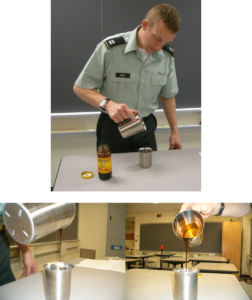Model Description
This is a demonstration of the concept of conservation of mass. By pouring an incompressible fluid (molasses), it is clearly demonstrated that as the velocity of the flow increases, the cross-sectional area of the flow must decrease. This demonstration should take 8-10 minutes.

Engineering Principle
Mass is conserved when the mass flow rate into the system equals the mass flow rate out of the system:
The mass flow of a fluid at any point is the product of the density, cross-sectional area and flow velocity. Therefore, we can rewrite the conservation of mass between points one and two as:
The density of molasses is assumed constant between points one and two and equation (2) reduces to:
If the cross-sectional area of the flow decreases (), then the flow velocity must increase to maintain the conservation of mass (
).
What You Need
| Item | Quantity | Description/Clarification |
|---|---|---|
| Jar of Molasses | 1 | Any kind will do. |
| Beaker | 1 | Any kind of cup will suffice to collect the molasses |
| Wet Paper Towels | 5-10 | Used for the inevitable mess |
How It’s Done
Before Class: Open the jar of molasses as it will inevitably be stuck shut otherwise during class.
In Class: After a discussion of the conservation of mass, pour the molasses from the jar or a cup into the beaker. The cross-sectional area of the flow initially () is large and the flow velocity (
) is low. As the flow accelerates due to gravity, the downstream velocity (
) increases (figure below, bottom left). As this velocity increases we see the cross-sectional area (
) decrease (figure below, bottom right).

Observations: Students should be able to observe how the cross-sectional area decreases as the velocity increases.
Additional Application: Ask the students for common examples where we increase the flow velocity by decreasing the area (i.e. shower head, squirt gun, etc.). Using these examples, draw a schematic of the device illustrating the conditions at points one and two.
